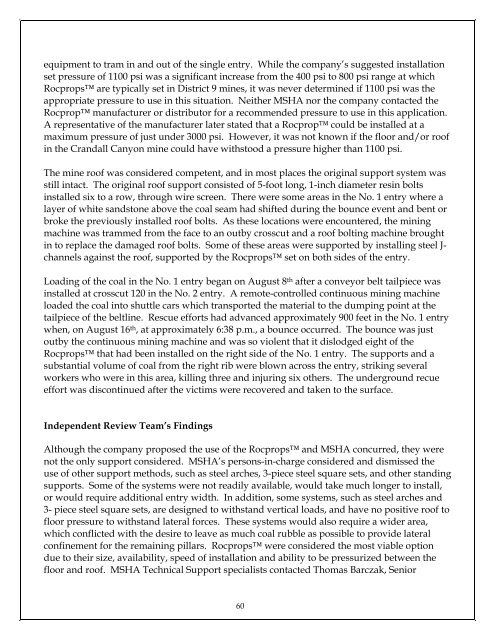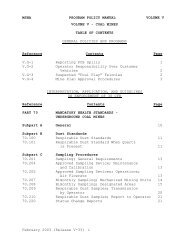Independent Review of MSHA's Actions at Crandall Canyon Mine
Independent Review of MSHA's Actions at Crandall Canyon Mine
Independent Review of MSHA's Actions at Crandall Canyon Mine
You also want an ePaper? Increase the reach of your titles
YUMPU automatically turns print PDFs into web optimized ePapers that Google loves.
equipment to tram in and out <strong>of</strong> the single entry. While the company’s suggested install<strong>at</strong>ion<br />
set pressure <strong>of</strong> 1100 psi was a significant increase from the 400 psi to 800 psi range <strong>at</strong> which<br />
Rocprops are typically set in District 9 mines, it was never determined if 1100 psi was the<br />
appropri<strong>at</strong>e pressure to use in this situ<strong>at</strong>ion. Neither MSHA nor the company contacted the<br />
Rocprop manufacturer or distributor for a recommended pressure to use in this applic<strong>at</strong>ion.<br />
A represent<strong>at</strong>ive <strong>of</strong> the manufacturer l<strong>at</strong>er st<strong>at</strong>ed th<strong>at</strong> a Rocprop could be installed <strong>at</strong> a<br />
maximum pressure <strong>of</strong> just under 3000 psi. However, it was not known if the floor and/or ro<strong>of</strong><br />
in the <strong>Crandall</strong> <strong>Canyon</strong> mine could have withstood a pressure higher than 1100 psi.<br />
The mine ro<strong>of</strong> was considered competent, and in most places the original support system was<br />
still intact. The original ro<strong>of</strong> support consisted <strong>of</strong> 5-foot long, 1-inch diameter resin bolts<br />
installed six to a row, through wire screen. There were some areas in the No. 1 entry where a<br />
layer <strong>of</strong> white sandstone above the coal seam had shifted during the bounce event and bent or<br />
broke the previously installed ro<strong>of</strong> bolts. As these loc<strong>at</strong>ions were encountered, the mining<br />
machine was trammed from the face to an outby crosscut and a ro<strong>of</strong> bolting machine brought<br />
in to replace the damaged ro<strong>of</strong> bolts. Some <strong>of</strong> these areas were supported by installing steel Jchannels<br />
against the ro<strong>of</strong>, supported by the Rocprops set on both sides <strong>of</strong> the entry.<br />
Loading <strong>of</strong> the coal in the No. 1 entry began on August 8 th after a conveyor belt tailpiece was<br />
installed <strong>at</strong> crosscut 120 in the No. 2 entry. A remote-controlled continuous mining machine<br />
loaded the coal into shuttle cars which transported the m<strong>at</strong>erial to the dumping point <strong>at</strong> the<br />
tailpiece <strong>of</strong> the beltline. Rescue efforts had advanced approxim<strong>at</strong>ely 900 feet in the No. 1 entry<br />
when, on August 16 th , <strong>at</strong> approxim<strong>at</strong>ely 6:38 p.m., a bounce occurred. The bounce was just<br />
outby the continuous mining machine and was so violent th<strong>at</strong> it dislodged eight <strong>of</strong> the<br />
Rocprops th<strong>at</strong> had been installed on the right side <strong>of</strong> the No. 1 entry. The supports and a<br />
substantial volume <strong>of</strong> coal from the right rib were blown across the entry, striking several<br />
workers who were in this area, killing three and injuring six others. The underground recue<br />
effort was discontinued after the victims were recovered and taken to the surface.<br />
<strong>Independent</strong> <strong>Review</strong> Team’s Findings<br />
Although the company proposed the use <strong>of</strong> the Rocprops and MSHA concurred, they were<br />
not the only support considered. MSHA’s persons-in-charge considered and dismissed the<br />
use <strong>of</strong> other support methods, such as steel arches, 3-piece steel square sets, and other standing<br />
supports. Some <strong>of</strong> the systems were not readily available, would take much longer to install,<br />
or would require additional entry width. In addition, some systems, such as steel arches and<br />
3- piece steel square sets, are designed to withstand vertical loads, and have no positive ro<strong>of</strong> to<br />
floor pressure to withstand l<strong>at</strong>eral forces. These systems would also require a wider area,<br />
which conflicted with the desire to leave as much coal rubble as possible to provide l<strong>at</strong>eral<br />
confinement for the remaining pillars. Rocprops were considered the most viable option<br />
due to their size, availability, speed <strong>of</strong> install<strong>at</strong>ion and ability to be pressurized between the<br />
floor and ro<strong>of</strong>. MSHA Technical Support specialists contacted Thomas Barczak, Senior<br />
60

















